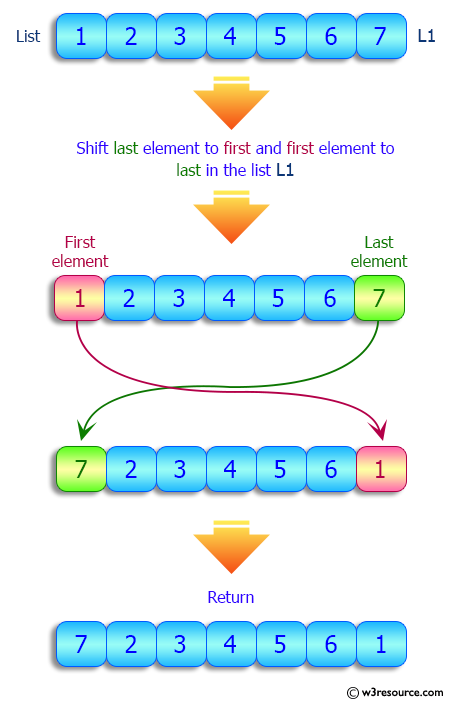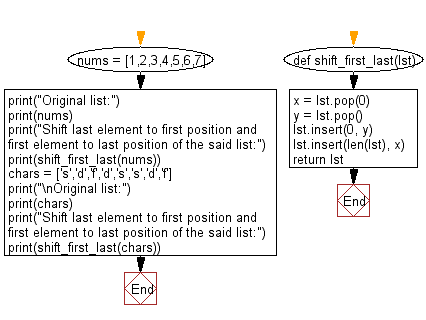Python: Shift last element to first position and first element to last position in a list
Swap First and Last Element
Write a Python program to shift last element to first position and first element to last position in a given list.
Visual Presentation:

Sample Solution:
Python Code:
# Define a function called 'shift_first_last' that shifts the first element to the last position and the last element to the first position of a list.
def shift_first_last(lst):
# Remove the first element and store it in 'x'.
x = lst.pop(0)
# Remove the last element and store it in 'y'.
y = lst.pop()
# Insert 'y' at the first position.
lst.insert(0, y)
# Insert 'x' at the last position.
lst.insert(len(lst), x)
return lst
# Create a list 'nums' containing integers.
nums = [1, 2, 3, 4, 5, 6, 7]
# Print a message indicating the original list.
print("Original list:")
# Print the original list 'nums'.
print(nums)
# Print a message indicating shifting the last element to the first position and the first element to the last position of the list.
print("Shift last element to first position and first element to last position of the said list:")
# Call the 'shift_first_last' function with 'nums' and print the result.
print(shift_first_last(nums))
# Create a list 'chars' containing characters.
chars = ['s', 'd', 'f', 'd', 's', 's', 'd', 'f']
# Print a message indicating the original list.
print("\nOriginal list:")
# Print the original list 'chars'.
print(chars)
# Print a message indicating shifting the last element to the first position and the first element to the last position of the list.
print("Shift last element to first position and first element to last position of the said list:")
# Call the 'shift_first_last' function with 'chars' and print the result.
print(shift_first_last(chars))
Sample Output:
Original list: [1, 2, 3, 4, 5, 6, 7] Shift last element to first position and first element to last position of the said list: [7, 2, 3, 4, 5, 6, 1] Original list: ['s', 'd', 'f', 'd', 's', 's', 'd', 'f'] Shift last element to first position and first element to last position of the said list: ['f', 'd', 'f', 'd', 's', 's', 'd', 's']
Flowchart:

For more Practice: Solve these Related Problems:
- Write a Python program to swap the first and last elements of a list and shift the remaining elements one position to the right.
- Write a Python program to swap the first and last elements only if both are prime numbers.
- Write a Python program to swap the first and last elements and then reverse the order of the middle section.
- Write a Python program to swap the first and last elements of a list after filtering out any None values.
Go to:
Previous: Write a Python program to sort a given list of tuples on specified element.
Next: Write a Python program to find the specified number of largest products from two given list, multiplying an element from each list.
Python Code Editor:
What is the difficulty level of this exercise?
Test your Programming skills with w3resource's quiz.
